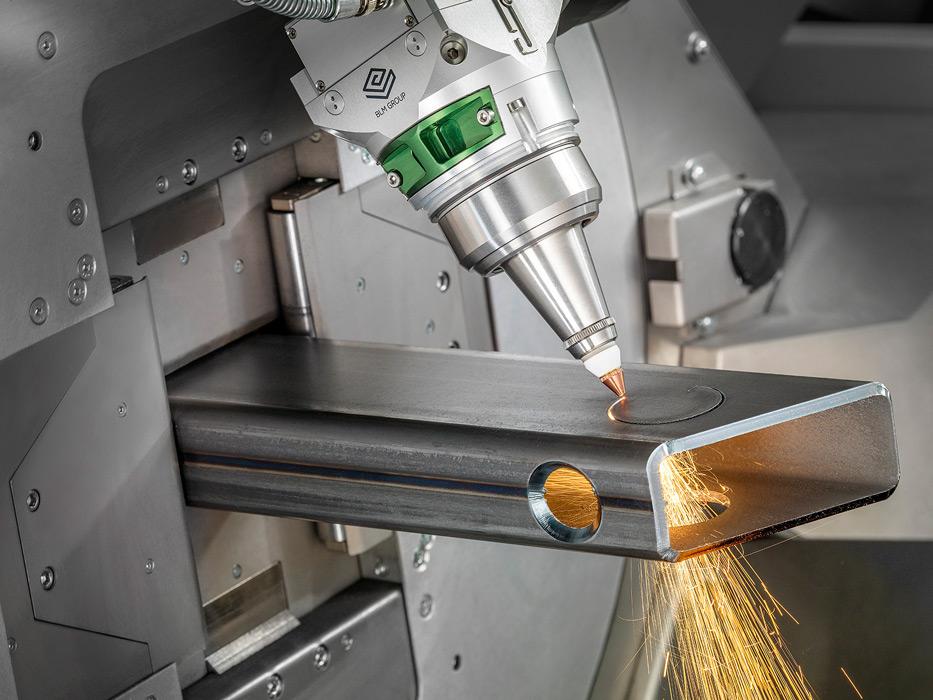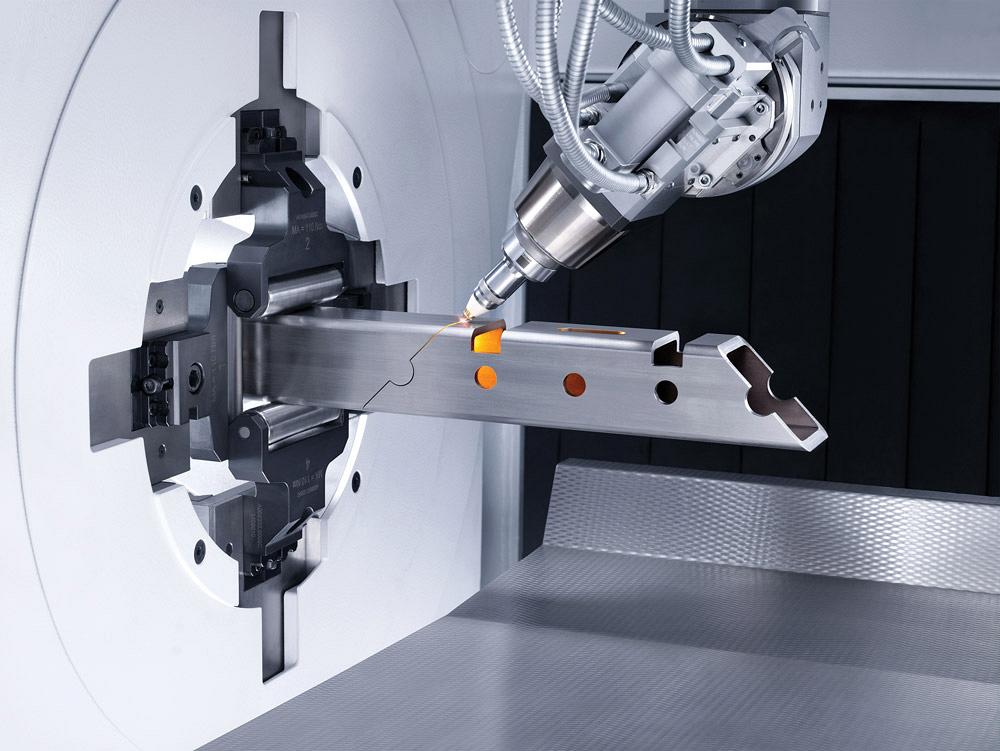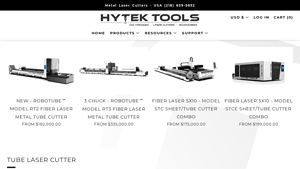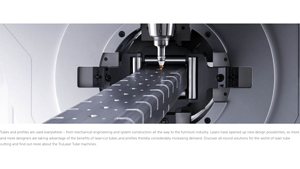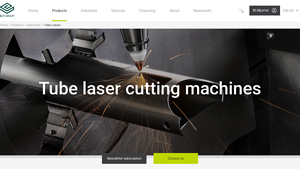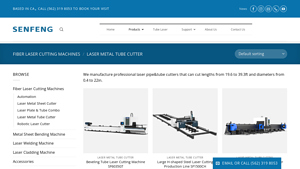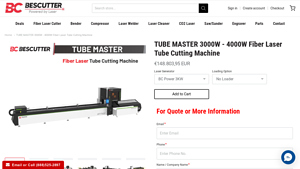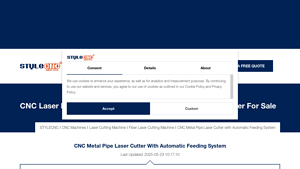Cnc Laser Cut Tube Guide: Type, Cost, Top List…
Introduction: Navigating the Global Market for cnc laser cut tube
In the ever-evolving landscape of global manufacturing, sourcing high-quality CNC laser cut tubes presents a significant challenge for international B2B buyers. As industries increasingly rely on precision-engineered components, understanding the nuances of CNC laser cutting technology becomes paramount. This guide delves into the multifaceted world of CNC laser cut tubes, exploring various types, applications across sectors, and the critical factors to consider when vetting suppliers.
Buyers from regions such as Africa, South America, the Middle East, and Europe—including emerging markets like Vietnam and Brazil—will find valuable insights tailored to their unique needs. With a focus on cost considerations, production capabilities, and quality assurance, this comprehensive resource empowers decision-makers to make informed purchasing choices. By addressing potential pitfalls and highlighting best practices, the guide aims to streamline the sourcing process and enhance operational efficiency.
Whether you are looking to optimize your supply chain or seeking innovative solutions for your next project, understanding the global market for CNC laser cut tubes will enable you to navigate this complex landscape with confidence. Embrace the opportunity to leverage cutting-edge technology and find the right partners to drive your business forward.
Understanding cnc laser cut tube Types and Variations
| Type Name | Key Distinguishing Features | Primary B2B Applications | Brief Pros & Cons for Buyers |
|---|---|---|---|
| Fiber Laser Tube Cutters | High speed, precision, and versatility; ideal for various materials | Automotive, aerospace, and furniture industries | Pros: Fast processing, low maintenance; Cons: Higher initial cost. |
| CO2 Laser Tube Cutters | Excellent for cutting non-metal materials; typically slower than fiber lasers | Sign-making, decorative applications | Pros: Versatile with softer materials; Cons: Less efficient for metals. |
| Combination Tube/Sheet Cutters | Can cut both tube and flat sheet materials; multi-functional | General fabrication, prototyping | Pros: Flexibility for different jobs; Cons: May have lower performance on specialized tasks. |
| Dedicated Tube Cutters | Specifically designed for tube cutting; accommodates long stock lengths | Structural applications, pipelines | Pros: Optimized for tube work; Cons: Limited to tube cutting only. |
| Automated Tube Cutting Systems | Fully automated systems with high throughput capabilities | High-volume production, mass customization | Pros: Increased efficiency, reduced labor costs; Cons: Higher upfront investment. |
What are Fiber Laser Tube Cutters and Their Benefits for B2B Buyers?
Fiber laser tube cutters are renowned for their speed and precision, making them ideal for high-volume applications in industries such as automotive and aerospace. They can cut through a variety of materials, including stainless steel and aluminum, with remarkable accuracy. B2B buyers should consider the initial investment, as these machines can be more expensive than other types. However, the long-term savings on operational costs and maintenance make them a worthwhile investment for companies looking to enhance productivity.
How Do CO2 Laser Tube Cutters Differ from Fiber Lasers?
CO2 laser tube cutters excel in cutting non-metal materials like plastics and wood, making them suitable for applications in sign-making and decorative industries. While they are generally slower than fiber lasers, they offer excellent versatility for softer materials. Buyers should weigh the benefits of versatility against the efficiency of fiber lasers, especially if their operations primarily involve metal cutting.
What Are the Advantages of Combination Tube/Sheet Cutters?
Combination tube/sheet cutters are designed for businesses that require flexibility in their cutting capabilities. These machines can handle both tube and flat sheet materials, making them ideal for general fabrication and prototyping. While they offer the advantage of multi-functionality, buyers should be aware that they may not perform as efficiently in specialized tasks compared to dedicated machines.
Why Choose Dedicated Tube Cutters for Specific Applications?
Dedicated tube cutters are tailored specifically for tube cutting, allowing for the processing of long stock lengths and various tube shapes. They are particularly beneficial in structural applications and pipeline manufacturing, where precision and efficiency are paramount. However, their limitation to tube cutting means that businesses requiring versatile machinery may need to consider additional equipment.
What Makes Automated Tube Cutting Systems Essential for High-Volume Production?
Automated tube cutting systems are designed for high-volume production environments, offering semi-to-fully automated processes that significantly reduce labor costs and increase throughput. These systems are ideal for companies focused on mass customization and efficiency. However, the initial investment is typically higher, which may be a consideration for smaller businesses or those with limited budgets.
Key Industrial Applications of cnc laser cut tube
| Industry/Sector | Specific Application of cnc laser cut tube | Value/Benefit for the Business | Key Sourcing Considerations for this Application |
|---|---|---|---|
| Automotive | Production of exhaust systems and chassis components | Enhanced precision and reduced material waste | Need for high tolerance specifications and rapid prototyping |
| Construction and Architecture | Custom railings and structural supports | Improved design flexibility and faster construction times | Consideration for local regulations and material availability |
| Furniture Manufacturing | Fabrication of metal furniture frames | Unique designs and high-quality finishes | Sourcing durable materials and ensuring consistent quality |
| Oil and Gas | Pipeline components and fittings | Increased efficiency in assembly and reduced costs | Need for corrosion-resistant materials and compliance standards |
| Aerospace | Manufacturing of structural components | Lightweight and strong components for improved performance | Strict adherence to aerospace regulations and certifications |
How is CNC Laser Cut Tube Used in the Automotive Industry?
In the automotive sector, CNC laser cut tubes are crucial for producing exhaust systems and chassis components. These parts require high precision and can significantly influence vehicle performance and emissions. By using laser cutting, manufacturers can achieve tight tolerances, reducing material waste and ensuring that every component fits perfectly. Buyers should focus on suppliers who can provide rapid prototyping and meet stringent automotive industry standards, especially in regions like Brazil and Vietnam where local regulations may vary.
What Role Does CNC Laser Cut Tube Play in Construction and Architecture?
CNC laser cut tubes are increasingly used in construction and architecture for creating custom railings and structural supports. This technology allows for intricate designs that enhance the aesthetic appeal of buildings while maintaining structural integrity. The ability to produce components quickly means that construction timelines can be shortened. International buyers should consider sourcing from manufacturers who understand local building codes and can provide materials that are readily available in their regions, especially in the Middle East and Africa.
How is CNC Laser Cut Tube Beneficial for Furniture Manufacturing?
In furniture manufacturing, CNC laser cut tubes are utilized to fabricate metal frames for various furniture items. This method allows for unique and customizable designs that can meet specific consumer demands. The precision of laser cutting ensures high-quality finishes, which are essential for aesthetic appeal. Buyers in this sector should prioritize suppliers who can deliver durable materials and maintain consistent quality, as these factors are critical for customer satisfaction and brand reputation.
What is the Importance of CNC Laser Cut Tube in the Oil and Gas Industry?
The oil and gas industry relies on CNC laser cut tubes for producing pipeline components and fittings. The precision and efficiency of laser cutting reduce the time and costs associated with assembly, which is vital for maintaining operational efficiency. Buyers in this sector must ensure that the materials sourced are corrosion-resistant and comply with industry standards. This is particularly important in regions with harsh environmental conditions, such as parts of South America and the Middle East.
How Does CNC Laser Cut Tube Enhance Aerospace Manufacturing?
In aerospace manufacturing, CNC laser cut tubes are essential for creating lightweight yet strong structural components. The aerospace industry demands high performance and stringent compliance with safety regulations, making precision cutting critical. Suppliers must be able to provide materials that meet these rigorous standards and certifications. International buyers should seek out manufacturers with proven experience in aerospace applications, particularly in Europe, where regulations are particularly strict.
3 Common User Pain Points for ‘cnc laser cut tube’ & Their Solutions
Scenario 1: Overcoming Inconsistent Quality in CNC Laser Cutting
The Problem: One significant challenge faced by B2B buyers in the CNC laser cut tube market is the inconsistency in quality across different suppliers. This inconsistency can manifest in various ways, such as varying tolerances, surface finishes, or even structural integrity of the cut tubes. Buyers may receive parts that do not meet their specifications or, worse, parts that fail during use, leading to costly rework or project delays. This unpredictability can stem from different manufacturing processes, machine capabilities, and the quality control measures employed by different suppliers.
The Solution: To ensure high-quality CNC laser cut tubes, buyers should prioritize sourcing from suppliers who demonstrate robust quality assurance processes. When evaluating potential vendors, look for certifications such as ISO 9001, which indicates a commitment to quality management. Additionally, request samples or prototypes before placing larger orders to assess the precision and finish of the cuts firsthand. Collaborating closely with suppliers during the design phase can also help clarify specifications, enabling them to better meet your needs. Implementing a quality control checklist for incoming parts can help catch discrepancies early in the production process, ultimately saving time and resources.
Scenario 2: Managing Lead Times and Delivery Challenges
The Problem: B2B buyers often face challenges related to lead times and delivery schedules when sourcing CNC laser cut tubes. Depending on the supplier’s capabilities, production capacity, and location, lead times can vary significantly. Unexpected delays can disrupt project timelines, especially in industries like automotive or construction, where timely delivery of components is critical. Buyers may find themselves in a position where they must scramble to find alternative sources, leading to increased costs and project inefficiencies.
The Solution: To mitigate lead time issues, B2B buyers should establish clear communication with their suppliers about expected delivery schedules and any potential bottlenecks in the production process. It’s advisable to implement a just-in-time (JIT) inventory strategy, where orders are placed based on demand rather than forecasts, allowing for more flexibility in managing inventory levels. Building relationships with multiple suppliers can also provide a safety net; if one supplier encounters delays, having alternatives can prevent project disruptions. Additionally, utilizing suppliers who offer expedited services or have automated systems in place can significantly reduce lead times.
Scenario 3: Navigating Material Selection and Cost Implications
The Problem: Another common pain point for buyers is the complexity of material selection for CNC laser cut tubes. Different applications may require specific materials, such as stainless steel, aluminum, or specialty alloys, each with varying costs and properties. Buyers may struggle to balance the need for high-quality materials that meet performance requirements against budget constraints. Inadequate material selection can lead to suboptimal performance in the final application, or overspending on materials that aren’t necessary for the intended use.
The Solution: To address material selection challenges, buyers should engage in thorough consultations with their suppliers or materials experts. By understanding the specific requirements of their applications, including strength, weight, and corrosion resistance, buyers can make informed decisions about the most suitable materials. Additionally, conducting a cost-benefit analysis can help identify the most economically viable options without compromising quality. Utilizing suppliers who provide material data sheets and have a robust understanding of material properties can aid in making the right choices. Lastly, exploring options for bulk purchasing or long-term contracts can offer financial advantages, reducing overall costs while ensuring access to high-quality materials.
Strategic Material Selection Guide for cnc laser cut tube
What Are the Key Materials for CNC Laser Cut Tubes?
When selecting materials for CNC laser cut tubes, it is essential to consider the specific properties, advantages, and limitations of each material. This analysis will focus on four common materials: stainless steel, aluminum, carbon steel, and brass. Each material presents unique characteristics that can significantly impact the performance and suitability of the final product.
How Does Stainless Steel Perform in CNC Laser Cutting Applications?
Stainless steel, particularly grades 304 and 316, is a popular choice for CNC laser cut tubes due to its excellent corrosion resistance and durability. It can withstand high temperatures and pressures, making it suitable for various applications, including automotive and industrial components. The key advantage of stainless steel is its strength and longevity, which reduces the need for frequent replacements.
However, stainless steel can be more expensive than other materials, which may be a concern for budget-conscious buyers. Additionally, the cutting process may require more power and slower speeds, increasing manufacturing complexity. For international buyers, compliance with standards such as ASTM A240 or DIN 1.4301 is crucial, especially in regions with stringent quality requirements.
What Are the Benefits of Using Aluminum for CNC Laser Cut Tubes?
Aluminum, especially the 6061 alloy, is favored for its lightweight properties and good corrosion resistance. It is easy to machine, allowing for faster production times and lower costs. Aluminum tubes are commonly used in applications such as aerospace, automotive, and construction, where weight savings are critical.
On the downside, aluminum has lower strength compared to stainless steel, which may limit its use in high-stress applications. Additionally, it can be more susceptible to deformation during the cutting process if not handled properly. International buyers should be aware of standards like ASTM B221 for aluminum products to ensure compliance with local regulations.
Why Choose Carbon Steel for CNC Laser Cut Tubes?
Carbon steel, particularly grades A513 and A36, is widely used for its cost-effectiveness and high tensile strength. It is suitable for structural applications and is often used in manufacturing machinery and equipment. The material’s availability and lower cost make it an attractive option for many businesses.
However, carbon steel is prone to rusting and corrosion if not properly treated, which can affect its longevity. Buyers should consider protective coatings or galvanization to enhance durability. Compliance with standards such as ASTM A500 is essential for international buyers, particularly in regions where quality assurance is mandated.
What Advantages Does Brass Offer in CNC Laser Cutting?
Brass is known for its excellent machinability and aesthetic appeal, making it a popular choice for decorative applications and plumbing fittings. It has good corrosion resistance and is often used in environments where exposure to moisture is a concern. The key advantage of brass is its ability to be easily shaped and formed, allowing for intricate designs.
The main disadvantage of brass is its higher cost compared to other materials like carbon steel and aluminum. Additionally, it may not be suitable for high-stress applications due to its lower tensile strength. International buyers should ensure compliance with standards such as ASTM B36 for brass products to meet local market requirements.
Summary Table of Material Selection for CNC Laser Cut Tubes
| Material | Typical Use Case for cnc laser cut tube | Key Advantage | Key Disadvantage/Limitation | Relative Cost (Low/Med/High) |
|---|---|---|---|---|
| Stainless Steel | Automotive and industrial components | Excellent corrosion resistance | Higher cost and slower cutting speeds | High |
| Aluminum | Aerospace and construction applications | Lightweight and easy to machine | Lower strength and deformation risk | Medium |
| Carbon Steel | Structural applications and machinery | Cost-effective and high tensile strength | Prone to rust without treatment | Low |
| Brass | Decorative applications and plumbing | Excellent machinability and aesthetics | Higher cost and lower tensile strength | Medium |
This comprehensive analysis provides B2B buyers with the necessary insights to make informed decisions regarding material selection for CNC laser cut tubes, considering both performance and compliance with international standards.
In-depth Look: Manufacturing Processes and Quality Assurance for cnc laser cut tube
What Are the Key Stages in the Manufacturing Process of CNC Laser Cut Tubes?
The manufacturing of CNC laser cut tubes involves several critical stages, each designed to ensure precision, efficiency, and quality. The main stages include material preparation, forming, assembly, and finishing.
-
Material Preparation: This initial phase begins with the selection of high-quality raw materials, typically metals such as stainless steel, aluminum, or alloy steel. The chosen tubes are then cut to the appropriate lengths, ensuring they meet specifications for the intended application. During this stage, it’s essential to inspect the material for defects and verify that it complies with industry standards.
-
Forming: The forming process utilizes CNC laser cutting technology to achieve intricate designs and precise cuts. Laser cutting machines, such as fiber or CO2 lasers, are programmed with CAD/CAM software to execute the desired shapes and features. This technology allows for clean edges and complex geometries while minimizing material wastage. Depending on the design, additional techniques such as bending or welding may be employed at this stage.
-
Assembly: If the final product requires multiple components, the assembly process integrates the laser-cut tubes with other parts. This may involve welding, fastening, or other joining techniques. Proper alignment and fitment are crucial to ensure the structural integrity of the final product.
-
Finishing: The finishing stage includes processes like deburring, polishing, and coating to enhance the aesthetic and functional properties of the tubes. This may also involve applying protective coatings to prevent corrosion and improve durability. Quality checks during this stage are essential to ensure that the finish meets customer specifications.
How Is Quality Assurance Integrated into the Manufacturing Process of CNC Laser Cut Tubes?
Quality assurance is a fundamental aspect of the CNC laser cut tube manufacturing process. It involves a series of systematic checks and balances to ensure that the final product meets international standards and customer expectations.
-
Relevant International Standards: Compliance with international quality standards such as ISO 9001 is crucial for manufacturers. This standard outlines requirements for a quality management system, emphasizing customer satisfaction and continuous improvement. Other industry-specific certifications, such as CE marking for European markets or API certification for oil and gas applications, may also apply depending on the product’s end-use.
-
Quality Control Checkpoints: Quality control is integrated at various checkpoints throughout the manufacturing process:
-
Incoming Quality Control (IQC): Raw materials are inspected upon arrival to ensure they meet specified standards. This includes checking for material certifications, dimensions, and any visible defects.
-
In-Process Quality Control (IPQC): During the manufacturing process, operators monitor parameters such as laser power, cutting speed, and material feed rates. Regular checks are conducted to ensure consistency and precision in the cutting process.
-
Final Quality Control (FQC): Once the manufacturing is complete, the finished products undergo rigorous testing. This includes dimensional checks, visual inspections, and functional testing to ensure they meet all specifications and quality standards.
- Common Testing Methods: Various testing methods are utilized to verify the quality of CNC laser cut tubes, including:
- Dimensional Inspection: Using calipers and gauges to measure the dimensions and tolerances of the cut tubes.
- Visual Inspection: Evaluating the surface finish and overall appearance to detect any defects.
- Mechanical Testing: Conducting tests like tensile strength, hardness, and impact resistance to ensure the materials meet performance requirements.
How Can B2B Buyers Verify Supplier Quality Control Processes?
For international B2B buyers, particularly in regions like Africa, South America, the Middle East, and Europe, verifying a supplier’s quality control processes is vital for ensuring product reliability and compliance with local regulations.
-
Supplier Audits: Conducting on-site audits can provide valuable insights into a manufacturer’s quality control practices. During an audit, buyers can evaluate the supplier’s adherence to quality standards, examine production processes, and assess the effectiveness of their quality management systems.
-
Quality Assurance Reports: Requesting detailed quality assurance reports from suppliers can help buyers understand the results of various quality checks and tests performed throughout the manufacturing process. These reports should include information on the methods used, frequency of testing, and any corrective actions taken in response to non-conformities.
-
Third-Party Inspections: Engaging third-party inspection services can add an extra layer of assurance. These independent organizations can conduct inspections and testing to verify that the products meet specified standards before shipment. This is particularly useful for buyers who may not have the resources to perform thorough in-house inspections.
What Are the Quality Control Nuances for International B2B Buyers?
When dealing with international suppliers, B2B buyers must be aware of specific nuances related to quality control. These include:
-
Cultural Differences: Different regions may have varying approaches to quality assurance and manufacturing standards. Understanding these cultural differences can help buyers navigate expectations and communication more effectively.
-
Regulatory Compliance: Each region may have its own set of regulations and standards that must be adhered to. Buyers should familiarize themselves with local requirements to ensure that the products they import are compliant.
-
Language Barriers: Effective communication is crucial for ensuring that quality expectations are met. Buyers should consider working with suppliers who can provide documentation and support in a language they understand, minimizing the risk of misunderstandings.
-
Logistical Considerations: Shipping and handling can affect product quality. Buyers should establish clear agreements regarding packaging, transport conditions, and handling procedures to mitigate risks during transit.
By understanding the manufacturing processes and quality assurance measures associated with CNC laser cut tubes, B2B buyers can make informed decisions and ensure they partner with suppliers who prioritize quality and reliability.
Practical Sourcing Guide: A Step-by-Step Checklist for ‘cnc laser cut tube’
In the competitive landscape of CNC laser cutting, sourcing the right tube cutting services is crucial for businesses aiming to enhance their production capabilities. This guide provides a step-by-step checklist to streamline your procurement process, ensuring you partner with reliable suppliers who meet your specific needs.
Step 1: Define Your Technical Specifications
Establishing clear technical specifications is the first step in your sourcing journey. This includes determining the types of materials you need (e.g., stainless steel, aluminum), the dimensions of the tubes, and the desired tolerances. Clarity on these aspects will help suppliers provide accurate quotes and ensure that the final products meet your operational requirements.
Step 2: Research Potential Suppliers
Conduct thorough research to identify potential suppliers who specialize in CNC laser cut tube services. Look for companies that have a proven track record and positive reviews in your industry. Utilize platforms such as industry-specific directories and trade shows to compile a list of candidates, paying close attention to their market presence and expertise.
Step 3: Evaluate Supplier Capabilities
Once you have a shortlist, it’s essential to evaluate each supplier’s capabilities. Assess their machinery, technology, and production processes to ensure they align with your needs. Consider factors such as the maximum tube size they can handle, the types of lasers used (fiber vs. CO2), and their ability to manage complex designs.
Step 4: Request Samples and Prototypes
Before finalizing your supplier, request samples or prototypes of their work. This step allows you to evaluate the quality of their cutting precision and material handling. Ensure that the samples meet your specifications for tolerances and surface finishes, as this can significantly impact the performance of your final products.
Step 5: Verify Certifications and Compliance
Check if the suppliers hold relevant certifications and comply with international standards. Certifications such as ISO 9001 demonstrate a commitment to quality management systems. Compliance with safety and environmental regulations is also critical, especially when sourcing from different regions.
Step 6: Assess Lead Times and Production Capacity
Understanding a supplier’s lead times and production capacity is vital for effective project planning. Inquire about their standard turnaround times for orders and their ability to scale production during peak demand. This information will help you manage your supply chain more effectively and avoid delays in your projects.
Step 7: Discuss Terms and Conditions
Finally, engage in discussions regarding pricing, payment terms, and warranty conditions. Ensure you have a clear understanding of the total costs involved, including shipping and tariffs, especially when dealing with international suppliers. Establishing clear contractual terms will protect your interests and clarify expectations on both sides.
By following these steps, B2B buyers can ensure a more effective and informed sourcing process for CNC laser cut tubes, ultimately leading to successful partnerships and high-quality outcomes.
Comprehensive Cost and Pricing Analysis for cnc laser cut tube Sourcing
Understanding the cost structure and pricing dynamics for CNC laser-cut tubes is essential for international B2B buyers, especially those from regions like Africa, South America, the Middle East, and Europe. This analysis breaks down the cost components, identifies pricing influencers, and provides actionable buyer tips to optimize purchasing decisions.
What Are the Key Cost Components in CNC Laser Cut Tube Sourcing?
-
Materials: The choice of material significantly impacts costs. Common materials for laser-cut tubes include stainless steel, aluminum, and alloy steel. Prices fluctuate based on market conditions, availability, and material specifications. Buyers should consider sourcing from suppliers with competitive material pricing to reduce overall costs.
-
Labor: Labor costs vary by region and the complexity of the cutting process. Skilled labor is required for operating CNC machines and for post-cutting processes, such as finishing and quality assurance. Countries with lower labor costs may present opportunities for savings, but this must be balanced against potential quality differences.
-
Manufacturing Overhead: Overhead includes expenses related to equipment maintenance, facility costs, and utilities. Efficient manufacturing processes can reduce overhead, which in turn lowers the price passed on to buyers.
-
Tooling: The cost of tooling, which involves the initial setup and maintenance of cutting tools, affects pricing. Customized tooling for specific projects may lead to higher costs, so buyers should assess whether such investments yield sufficient returns.
-
Quality Control (QC): Rigorous QC processes ensure that products meet specifications and standards. While this adds to costs, it is critical for maintaining quality and compliance, particularly for industries with stringent requirements.
-
Logistics: Shipping and handling costs can be significant, especially for international transactions. Factors such as distance, shipping method, and local tariffs must be considered. Choosing suppliers with efficient logistics networks can help mitigate these expenses.
-
Margin: Suppliers typically build a margin into their pricing to cover their risks and ensure profitability. Understanding the supplier’s cost structure can provide insights into potential negotiation points.
How Do Volume and Specifications Influence Pricing?
Volume/MOQ: Larger orders often result in lower per-unit costs due to economies of scale. Establishing a Minimum Order Quantity (MOQ) can affect pricing, so buyers should negotiate to find a balance between their needs and the supplier’s requirements.
Specifications and Customization: Custom designs or specifications can increase costs due to additional setup and processing time. Buyers should weigh the benefits of customization against the potential price increases.
Materials and Quality Certifications: The choice of materials and whether they meet industry certifications can influence pricing. Higher-quality materials or certifications (like ISO or ASTM standards) typically command higher prices, but they may reduce long-term costs through enhanced durability and performance.
Supplier Factors: The supplier’s reputation, experience, and location can affect pricing. Established suppliers may charge a premium but often provide better reliability and quality assurance.
Incoterms: Understanding the agreed Incoterms (International Commercial Terms) is crucial for budgeting logistics costs. Terms like FOB (Free on Board) and CIF (Cost, Insurance, and Freight) dictate who bears the costs and risks at various stages of shipping, impacting the total landed cost.
What Are the Best Practices for B2B Buyers in CNC Laser Cut Tube Sourcing?
-
Negotiation: Leverage volume purchases and long-term contracts to negotiate better prices. Establishing strong relationships with suppliers can lead to favorable terms and pricing.
-
Cost-Efficiency: Conduct a Total Cost of Ownership analysis to evaluate all associated costs, including production, logistics, and maintenance. This perspective helps in identifying the most cost-effective suppliers.
-
Pricing Nuances for International Buyers: International buyers should be aware of currency fluctuations, import duties, and taxes that can affect overall pricing. Collaborating with suppliers who understand local regulations can streamline the process and mitigate unexpected costs.
-
Disclaimer for Indicative Prices: Prices can vary widely based on multiple factors. It is advisable to seek quotes tailored to specific requirements to obtain the most accurate pricing.
By thoroughly understanding these aspects, international B2B buyers can make informed decisions, optimize their sourcing strategies, and ultimately enhance their competitive edge in the market for CNC laser-cut tubes.
Alternatives Analysis: Comparing cnc laser cut tube With Other Solutions
Understanding Alternative Solutions to CNC Laser Cut Tube
In the realm of industrial manufacturing, particularly in tube processing, businesses often seek various methods to achieve their cutting and shaping needs. While CNC laser cutting offers precision and efficiency, several alternatives may cater to specific operational requirements or budget constraints. This section compares CNC laser cut tubes with other viable solutions, helping international B2B buyers make informed decisions.
| Comparison Aspect | Cnc Laser Cut Tube | Waterjet Cutting | Plasma Cutting |
|---|---|---|---|
| Performance | High precision, intricate designs | Excellent for thick materials | Faster for thicker metals |
| Cost | Higher initial investment, low operational cost | Moderate to high investment, consumables needed | Lower initial cost, higher operational cost |
| Ease of Implementation | Requires skilled operators and setup | Easier setup with minimal training | Relatively easy, but requires safety training |
| Maintenance | Low maintenance with routine checks | Moderate maintenance for pumps | High maintenance due to wear and tear |
| Best Use Case | Complex geometries, high volume production | Large, thick materials, no heat-affected zones | Heavy-duty applications, less precision required |
What Are the Advantages and Disadvantages of Waterjet Cutting Compared to CNC Laser Cut Tube?
Waterjet cutting utilizes high-pressure water mixed with abrasive particles to cut through materials. This method excels in cutting thick materials without altering their structural integrity, making it ideal for metals that are sensitive to heat. However, while the initial investment may be moderate, the operational costs can increase due to the need for consumables, such as abrasives and water filtration systems. Additionally, while waterjet cutting can achieve a good level of precision, it may not match the intricate designs possible with laser cutting.
How Does Plasma Cutting Compare to CNC Laser Cut Tube?
Plasma cutting employs a high-velocity jet of ionized gas to cut through electrically conductive materials. This method is advantageous for its speed, especially with thicker metals, making it suitable for heavy-duty applications. However, the precision of plasma cutting is generally lower than that of CNC laser cutting, and it may not be suitable for intricate designs. While the initial setup cost is lower, operational costs can be higher due to the rapid wear of consumables and the need for regular maintenance.
How Should B2B Buyers Choose the Right Solution for Their Needs?
When selecting the right cutting solution, B2B buyers should consider their specific production requirements, including material types, thicknesses, and design complexities. For projects requiring high precision and complex geometries, CNC laser cutting is often the best choice, despite the higher upfront costs. In contrast, for applications involving thicker materials where heat distortion is a concern, waterjet cutting might be more appropriate. Plasma cutting can serve well for larger, less precise projects where speed is prioritized. Ultimately, evaluating these factors against budget constraints and operational capabilities will guide buyers toward the most suitable solution for their needs.
Essential Technical Properties and Trade Terminology for cnc laser cut tube
Understanding the essential technical properties and terminology associated with CNC laser cut tubes is crucial for international B2B buyers, especially when navigating markets in regions such as Africa, South America, the Middle East, and Europe. This section outlines key specifications and commonly used terms, providing clarity and actionable insights for decision-makers.
What Are the Critical Technical Specifications for CNC Laser Cut Tubes?
-
Material Grade
– Definition: The classification of the material used for the tube, such as stainless steel (e.g., 304, 316), aluminum (e.g., 6061), or carbon steel.
– B2B Importance: Material grade affects durability, corrosion resistance, and suitability for specific applications. Understanding material properties ensures that the selected tube meets project requirements. -
Wall Thickness
– Definition: The measurement of the tube’s wall from the outer surface to the inner surface, typically expressed in inches or millimeters.
– B2B Importance: Wall thickness influences the strength and weight of the tube. Accurate specifications prevent structural failures and ensure compatibility with design requirements. -
Tolerance
– Definition: The allowable deviation from specified dimensions, often expressed as a plus/minus value (e.g., ±0.01 inches).
– B2B Importance: Tight tolerances are essential for ensuring that components fit together correctly, particularly in precision engineering applications. Higher tolerances can lead to increased production costs but are necessary for high-performance applications. -
Cutting Speed
– Definition: The rate at which the laser cutter moves along the material, usually measured in inches per minute (IPM).
– B2B Importance: Faster cutting speeds can enhance productivity and reduce lead times. However, optimal speeds must be balanced against cut quality to avoid defects. -
Kerf Width
– Definition: The width of the material that is removed during the cutting process, which varies based on the laser type and settings.
– B2B Importance: Understanding kerf width is critical for material optimization and waste reduction. It helps in calculating the actual dimensions of the final product. -
Assist Gas Type
– Definition: The gas used during the cutting process, commonly nitrogen or oxygen, which helps in enhancing cut quality.
– B2B Importance: The choice of assist gas can affect the final surface finish and cutting speed. Selecting the right gas is vital for achieving desired quality standards in the final product.
What Are Commonly Used Terms in CNC Laser Cutting?
-
OEM (Original Equipment Manufacturer)
– Definition: A company that produces parts or equipment that may be marketed by another manufacturer.
– Importance: OEM relationships are crucial for buyers seeking reliable suppliers for components that meet specific quality standards. -
MOQ (Minimum Order Quantity)
– Definition: The smallest quantity of product that a supplier is willing to sell.
– Importance: Understanding MOQ is vital for budgeting and inventory management, particularly for smaller businesses that may not require large quantities. -
RFQ (Request for Quotation)
– Definition: A standard business process where buyers request price quotes from suppliers for specific products or services.
– Importance: RFQs help buyers compare costs, assess suppliers’ capabilities, and streamline the procurement process. -
Incoterms (International Commercial Terms)
– Definition: A set of internationally recognized rules that define the responsibilities of sellers and buyers in the shipping of goods.
– Importance: Familiarity with Incoterms is essential for international transactions, as they clarify costs, risks, and logistics involved in shipping. -
CAD (Computer-Aided Design)
– Definition: Software used for creating precision drawings or technical illustrations.
– Importance: CAD files are essential for CNC laser cutting, allowing for precise and customized cuts based on digital designs. -
Lead Time
– Definition: The time taken from the initiation of an order to its completion.
– Importance: Understanding lead times is crucial for project scheduling and inventory management, enabling businesses to plan effectively.
By grasping these technical specifications and trade terminologies, B2B buyers can make informed decisions that align with their project goals and operational needs.
Navigating Market Dynamics and Sourcing Trends in the cnc laser cut tube Sector
What Are the Current Market Dynamics and Key Trends in the CNC Laser Cut Tube Sector?
The global CNC laser cut tube market is experiencing significant growth, driven by increasing demand across various industries including automotive, aerospace, construction, and furniture design. Key trends influencing this market include the integration of Industry 4.0 technologies, such as automation and IoT, which enhance operational efficiency and reduce production costs. Additionally, advancements in laser cutting technology, particularly fiber lasers, are making it possible to achieve faster cutting speeds and improved precision, which are critical for meeting the specific requirements of international buyers.
Emerging B2B sourcing trends are also reshaping the landscape. International buyers from Africa, South America, the Middle East, and Europe are increasingly seeking suppliers that offer not only competitive pricing but also flexibility in production capabilities. This shift is particularly evident in regions like Vietnam and Brazil, where local manufacturers are adopting advanced CNC technologies to meet the growing demand for customized solutions. Furthermore, the move towards just-in-time manufacturing is prompting buyers to favor suppliers who can provide rapid prototyping and short lead times, thereby reducing inventory costs.
The market dynamics are also characterized by a competitive landscape where established players are expanding their product offerings to include more versatile machines that can handle various tube shapes and sizes. For B2B buyers, this presents an opportunity to source from a diverse range of suppliers, allowing for better negotiation terms and improved supply chain resilience.
How Is Sustainability and Ethical Sourcing Impacting the CNC Laser Cut Tube Sector?
Sustainability has become a central concern in the CNC laser cut tube sector, influencing purchasing decisions among B2B buyers. The environmental impact of manufacturing processes is under scrutiny, leading companies to adopt greener practices. This includes minimizing material waste through advanced cutting technologies, which significantly reduce the kerf size compared to traditional methods. As a result, manufacturers can optimize material usage, contributing to lower carbon footprints.
The importance of ethical sourcing is also gaining traction, with buyers increasingly prioritizing suppliers that adhere to sustainable practices. This encompasses the use of responsibly sourced materials, energy-efficient manufacturing processes, and fair labor practices. Certifications such as ISO 14001 for environmental management and other green certifications can serve as critical indicators of a supplier’s commitment to sustainability.
Moreover, the demand for ‘green’ materials, such as recycled metals or those with lower environmental impacts, is on the rise. B2B buyers are encouraged to engage with suppliers who can provide transparency regarding their supply chains and demonstrate a commitment to sustainability. This not only enhances corporate responsibility but also aligns with the growing consumer expectation for environmentally friendly products.
What Is the Brief Evolution and History of CNC Laser Cutting Technology?
The evolution of CNC laser cutting technology dates back to the 1960s when lasers were first used for industrial cutting applications. Initially, the technology was limited by the high costs and complexities associated with laser systems. However, advancements in laser technology and computer numerical control (CNC) systems over the past few decades have significantly transformed the industry.
By the 1980s, the introduction of CO2 lasers made laser cutting more accessible, leading to widespread adoption in various manufacturing sectors. The 2000s marked a notable shift with the advent of fiber laser technology, which provided higher efficiency, lower operational costs, and greater versatility in cutting different materials. As a result, CNC laser cutting has become a preferred method for tube processing, allowing manufacturers to produce intricate designs and components with exceptional accuracy.
Today, CNC laser cutting technology continues to evolve, incorporating smart technologies and automation to meet the demands of a fast-paced global market. This ongoing development not only enhances the capabilities of manufacturers but also supports the growing trend toward customized and on-demand production, making it a vital asset for B2B buyers in the CNC laser cut tube sector.
Frequently Asked Questions (FAQs) for B2B Buyers of cnc laser cut tube
-
How do I choose the right CNC laser cut tube supplier?
Selecting the right supplier for CNC laser cut tubes involves evaluating their experience, technology, and customer reviews. Look for suppliers with a robust portfolio and expertise in your specific industry. Request samples to assess quality and precision. Additionally, inquire about their production capabilities, lead times, and flexibility in order sizes. It’s also beneficial to understand their quality assurance processes and certifications, ensuring they meet international standards. -
What materials can be used for CNC laser cut tubes?
CNC laser cutting can handle a variety of materials, including stainless steel, aluminum, carbon steel, and alloy steel. The choice of material depends on the intended application and desired properties such as strength, weight, and corrosion resistance. Stainless steel is popular for its durability and aesthetic appeal, while aluminum is favored for its lightweight characteristics. Ensure your supplier can accommodate the specific material requirements for your project. -
What is the typical minimum order quantity (MOQ) for CNC laser cut tubes?
Minimum order quantities for CNC laser cut tubes can vary significantly based on the supplier and the complexity of the design. Generally, suppliers may have an MOQ ranging from a few pieces to hundreds. It’s essential to discuss your specific needs with potential suppliers, as some may offer flexibility for smaller orders, especially for prototyping or custom projects. Understanding MOQ can help in budget planning and inventory management. -
What customization options are available for CNC laser cut tubes?
Customization options for CNC laser cut tubes include varying dimensions, shapes, and hole patterns tailored to your specifications. Many suppliers offer design assistance to help optimize the tube design for functionality and aesthetics. Additionally, you can specify surface finishes, such as powder coating or anodizing, to enhance durability and appearance. Discuss your requirements with the supplier to explore the full range of customization possibilities. -
How are payment terms typically structured for international orders?
Payment terms for international orders of CNC laser cut tubes can vary widely, but common practices include upfront payments, partial payments, or letters of credit. Many suppliers may require a deposit upon order confirmation, with the balance due before shipment. It’s crucial to negotiate terms that align with your cash flow while ensuring the supplier’s confidence in fulfilling your order. Always clarify payment methods, currency, and any additional costs such as tariffs or shipping fees. -
What quality assurance measures should I expect from my supplier?
Reputable suppliers of CNC laser cut tubes should implement rigorous quality assurance measures, including ISO certifications and adherence to international manufacturing standards. Expect them to conduct inspections at various stages of production, from material sourcing to final output. Request documentation such as material certifications and inspection reports to verify quality. Understanding their QA processes can provide peace of mind regarding the reliability and performance of the products you receive. -
What logistics considerations should I keep in mind when sourcing CNC laser cut tubes?
When sourcing CNC laser cut tubes internationally, logistics are critical. Consider shipping methods, costs, and transit times, which can vary by region. Ensure your supplier has experience with international shipping and can handle customs documentation efficiently. Discuss potential challenges such as import duties, tariffs, and local regulations in your country. It’s advisable to work with logistics partners who can provide tracking and support throughout the shipping process. -
How can I ensure timely delivery of CNC laser cut tubes?
To ensure timely delivery of CNC laser cut tubes, establish clear timelines with your supplier from the outset. Provide them with accurate forecasts of your needs, and inquire about their production capacity and lead times. Regular communication is key; maintain contact during the manufacturing process to address any potential delays proactively. Additionally, consider suppliers who offer expedited shipping options if you have urgent requirements.
Important Disclaimer & Terms of Use
⚠️ Important Disclaimer
The information provided in this guide, including content regarding manufacturers, technical specifications, and market analysis, is for informational and educational purposes only. It does not constitute professional procurement advice, financial advice, or legal advice.
While we have made every effort to ensure the accuracy and timeliness of the information, we are not responsible for any errors, omissions, or outdated information. Market conditions, company details, and technical standards are subject to change.
B2B buyers must conduct their own independent and thorough due diligence before making any purchasing decisions. This includes contacting suppliers directly, verifying certifications, requesting samples, and seeking professional consultation. The risk of relying on any information in this guide is borne solely by the reader.
Top 7 Cnc Laser Cut Tube Manufacturers & Suppliers List
1. Hytek Tools – Tube Laser Cutters
Domain: hytektools.com
Registered: 2015 (10 years)
Introduction: This company, Hytek Tools – Tube Laser Cutters, is a notable entity in the market. For specific product details, it is recommended to visit their website directly.
2. Trumpf – TruLaser Tube Series
Domain: trumpf.com
Registered: 1996 (29 years)
Introduction: TruLaser Tube 3000 fiber: Economical, reliable, easy to operate, ideal for first-time users or as a supplementary machine. TruLaser Tube 5000 fiber: Achieves record speeds, utilizes solid-state lasers for short processing times and a wide range of possible parts. TruLaser Tube 7000 fiber: Built for maximum productivity, suitable for XXL tubes, robust solid-state laser for various materials and wal…
3. BLM Group – Lasertube Systems
Domain: blmgroup.com
Registered: 2000 (25 years)
Introduction: Lasertube systems are 2D and 3D laser cutting systems for tubes, bars, and profiles, with diameters ranging from 12 mm to 610 mm (.5” to 24″) and lengths up to 18 m (60′). Key models include: LT5.10 (2D cut, tubes up to ∅ 4.72″), LTX (2D cutting mode, tubes up to ∅ 6″), LT6 (3D cutting mode, tubes up to ∅ 6″), LT7 (3D cutting mode, tubes from 0.5″ to 6″), LT8.20 (3D cutting mode, tubes from 0.5″ t…
4. SENFENG – Laser Metal Tube Cutters
Domain: senfenglaserusa.com
Registered: 2016 (9 years)
Introduction: Laser Metal Tube Cutter specifications include: 1. Cutting lengths: 19.6 to 39.3 feet. 2. Cutting diameters: 0.4 to 22 inches. 3. Power options: 1kW to 12kW. 4. Models include: SF6035GT (Beveling Tube Laser Cutting Machine), SF1500CH (Large H-shaped Steel Laser Cutting Production Line), ST Series (Three-chuck Heavy-duty Tube Laser Cutting Machine), T Series (Two-chuck Tube Laser Cutting Machine), …
5. BES Cutter – TUBE MASTER 3000W – 4000W Fiber Laser Tube Cutting Machine
Domain: bescutter.com
Registered: 2018 (7 years)
Introduction: {“product_name”: “TUBE MASTER 3000W – 4000W Fiber Laser Tube Cutting Machine”, “price_range”: “17000000 – 20000000”, “laser_generator_options”: [“BC Power 3KW”, “BC Power 4KW”, “IPG 3KW”], “loading_option”: [“No Loader”, “Magazine Style”, “Auto Loader”], “specifications”: {“optional_diameter”: “Ø10mm-Ø120mm (0.39″ – 4.7″)”, “tube_range_length”: “295” (7500 mm)”, “tube_diameter_standard”: “0.78”- 8…
6. OSH Cut – Precision Laser Tube Cutting
Domain: oshcut.com
Registered: 2018 (7 years)
Introduction: OSH Cut offers precision laser tube cutting for circular, square, and rectangular profiles in steel, aluminum, and stainless. Edges can be bevel cut at angles up to 45 degrees. The company can cut tube profiles up to 10 inches in diameter. Laser tube cutting provides high accuracy within thousandths of an inch, allowing for complex profiles and self-fixture designs that facilitate downstream fit u…
7. STYLECNC – CNC Metal Pipe Laser Cutter
Domain: stylecnc.com
Registered: 2015 (10 years)
Introduction: CNC Metal Pipe Laser Cutter with Automatic Feeding System
– Brand: STYLECNC
– Model: ST-FC6012K
– Laser Source: MAX, Raycus, IPG
– Power Options: 1500W, 3000W, 6000W
– Price Range: $25,000 – $66,800
– Features:
– Automatic feeder for loading/unloading tubes
– Chuck for rotating pipes
– Cuts round, square, rectangular, flat pipes, flanges, channel beams, U-tubes, and special-shaped metal tub…
Strategic Sourcing Conclusion and Outlook for cnc laser cut tube
Why Is Strategic Sourcing Essential for CNC Laser Cut Tube Procurement?
In today’s competitive landscape, strategic sourcing for CNC laser cut tubes is paramount for international B2B buyers. By leveraging advanced laser cutting technology, companies can achieve precision, reduce material waste, and streamline production processes. The ability to cut various tube shapes and materials efficiently not only enhances product quality but also opens avenues for innovative designs across industries, from automotive to furniture manufacturing.
How Can International Buyers Benefit from Optimized Sourcing Strategies?
For businesses in Africa, South America, the Middle East, and Europe, establishing strong supplier relationships is crucial. By partnering with reputable manufacturers and service providers, buyers can ensure access to the latest technology and expertise, facilitating improved lead times and cost-effectiveness. Understanding local market dynamics and regulatory frameworks will further bolster procurement strategies.
What Does the Future Hold for CNC Laser Cut Tubes in Global Markets?
Looking ahead, the demand for CNC laser cut tubes is expected to grow as industries increasingly adopt automation and seek to optimize production. International buyers should actively explore opportunities to enhance their sourcing strategies, adapting to market trends and technological advancements. By prioritizing strategic partnerships and embracing innovation, businesses can position themselves at the forefront of this evolving sector. Engage with suppliers today to unlock the full potential of CNC laser cut tubes for your operations.
